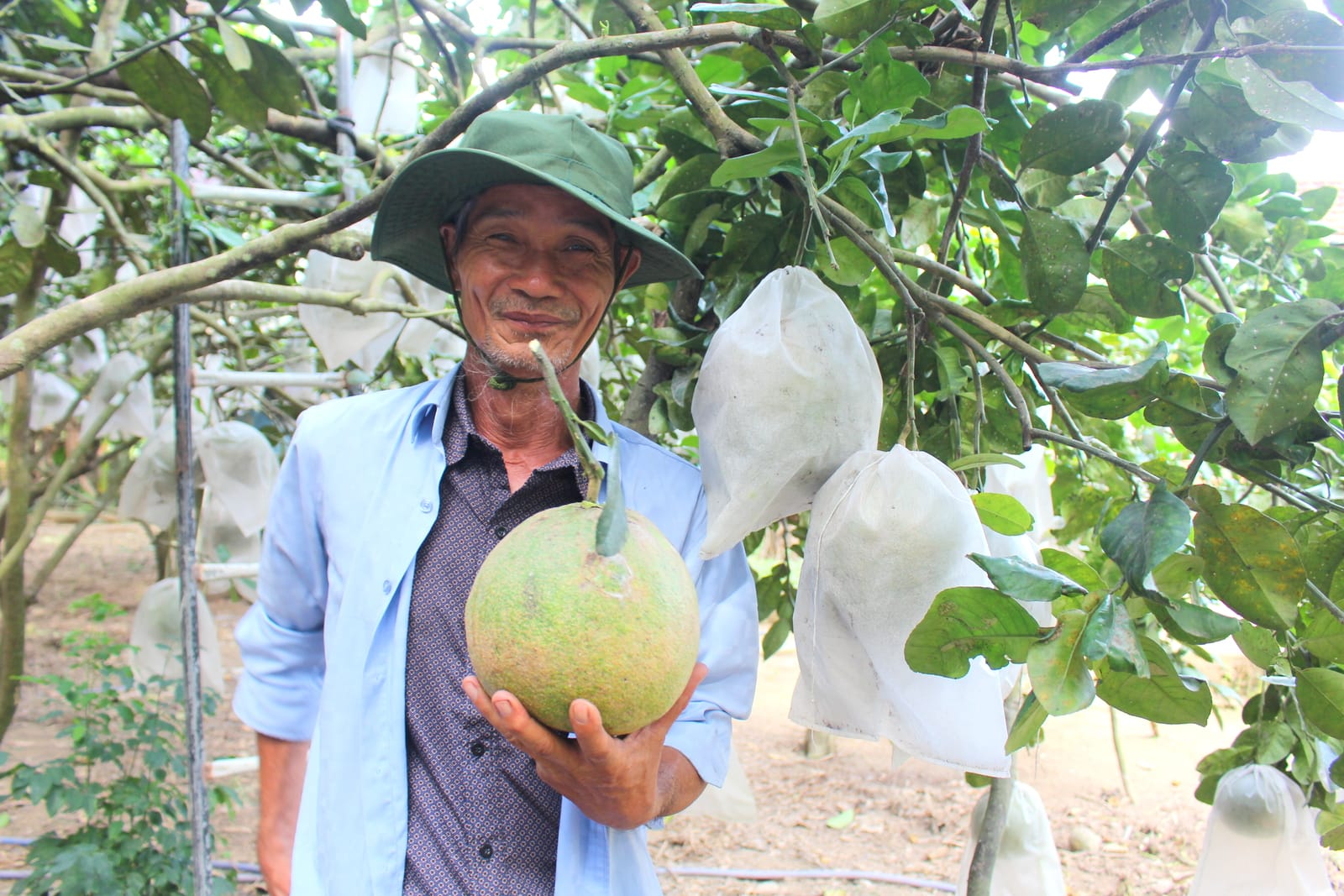Reviving abandoned farmlands
Dozens of hectares of abandoned agricultural land in Da Nang’s Hoa Vang District are being gradually “greened” thanks to policies aimed at restoring production, and converting crops.
 |
| Farmers in Hoa Phu Commune are aiming to grow green-skinned grapefruit trees on abandoned agricultural land in the near future. Photo: T.S. |
Reviving “golden fields”
Each morning, before sunrise, Mr. Nguyen Van Dung, from Hoa Tho Village, Hoa Phu Commune, Hoa Vang District, rides a few kilometres to An Chau field to start his workday. There, he manages over a hectare of land used for growing vegetables and watermelon, and raising black apple snails. To obtain this land, he rented fallow rice paddies and unused plots from residents for VND 100 million over five years.
Mr. Dung recalls that at the beginning of the restoration process, the fallow land, hardened and overgrown with weeds, required significant effort to recover. Organic fertiliser became his choice as it not only provided nutrients but also improved soil structure, enhancing its moisture retention capacity. “Chemical fertilisers are faster, but they degrade the soil and pollute water sources. Though slower, organic fertilisers ensure long-term sustainability” Mr. Dung noted.
Since 2021, local efforts have helped revive over 15 hectares of the total 20 hectares of abandoned farmland, including nearly 10 hectares converted back to rice cultivation and 5 hectares used for growing lotus and water lilies, and farming black apple snails. Residents are hopeful as rice yields on the reclaimed land have reached approximately 70 quintals per hectare over two consecutive years, raising expectations for future bountiful harvests.
Mr. Dung adopts sustainable practices, using decomposed animal manure, green fertilisers from plants, and agricultural by-products like straw and kitchen waste. Alongside fertilising, he applies efficient ploughing techniques to allow the soil to better absorb nutrients. These efforts not only benefit current crops but also improve future yields by restoring the land's biodiversity.
Once satisfied with the soil’s quality, he developed an organic farm, balancing commercial snail farming with the cultivation of seasonal fruits and vegetables, such as watermelon and grapes.
Before moving his farm to An Chau field, Dung had two years’ experience farming in Hoa Khuong Commune, where he earned an average income of VND 10 million per month from raising snails in three ponds on 1,000 square metres of land. His model integrates snail farming with vegetable cultivation, promoting ecological balance and sustainability. Water from the snail ponds is reused for irrigation, reducing the need for fertiliser and freshwater. Crops like grapes and watermelon, which yield high economic value, are easy to sell.
Mr. Dung's experience reflects a growing trend among other farmers in Hoa Phu Commune, who recognise the importance of sustainable land management. Formerly abandoned rice fields are once again flourishing, thanks to the vibrant green of new crops.
According to Mr. Nguyen Hai Cuong, Vice Chairman of the People's Committee of Hoa Phu Commune, the commune has over 73 hectares of agricultural land, of which 5 hectares were left fallow due to project delays and a lack of irrigation. By 2025, the commune aims to restore all fallow land for agricultural production.
Mr. Cuong added that the commune fully supports those who are proactive in reviving abandoned land, like Mr. Dung. “We are implementing support programmes, from providing seeds and organic fertiliser to teaching cultivation techniques. Farmers who are determined and adopt sustainable agricultural models will receive maximum local support. In the future, authorities in Hoa Phu Commune plan not only to restore land but also to build eco-agricultural models linked with tourism. Clean farms like Mr. Dung’s are part of a larger plan to make Hoa Phu an attractive destination,” Mr. Cuong said.
Building connected community
As of early 2024, Da Nang had around 348.44 hectares of abandoned agricultural land, mostly in Hoa Vang District. In addition to the 276 hectares reserved for future projects, there are over 13 hectares available for rehabilitation.
Secretary of the Hoa Vang District Party Committee To Van Hung noted that local authorities have surveyed the abandoned farmland and included it in their restoration plans. From 2024, the district will restore at least 2 hectares of land per commune annually, with the Farmers' Union leading the implementation of water channel improvements, crop selection, and cultivation techniques.
To date, farmers in Hoa Vang District have collectively restored over 51 hectares of abandoned farmland. According to Ms. Nguyen Thi Van, Chairwoman of the Hoa Vang Farmers' Union, crop selection is based on soil conditions and water availability, prioritising drought-tolerant crops such as vegetables, watermelon, maize, and shallots. Areas with better water conditions are used for rice, lotus, and fruit cultivation.
“We regularly guide farmers in new cultivation methods, such as using organic fertilisers and managing water resources efficiently. Our goal is not only to revive abandoned land but also to improve yields and ensure long-term stable incomes,” Ms. Van explained.
The district is also promoting cooperation between farmers to form production groups, reducing cultivation costs and enhancing the competitiveness of local agricultural products. Since 2021, thanks to efforts encouraging people to “resume production” more than 15 hectares of abandoned farmland have been reclaimed in Hoa Tien Commune. Nearly 10 hectares have been converted back to rice farming, and 5 hectares have been used to grow lotus and water lilies and raise black apple snails. The reclaimed land has produced an average of 70 quintals of rice per hectare over the past two years, giving hope for future plentiful harvests.
Across the fields of Hoa Vang District, the once-abandoned land has been replaced with the green of rice, vegetables, and organic and high-quality agricultural models. This transformation not only brings economic benefits but also fosters a sense of community as farmers share experiences and support each other in developing sustainable, green agriculture.
Reporting by TIEU YEN - Translating by TRUC VY